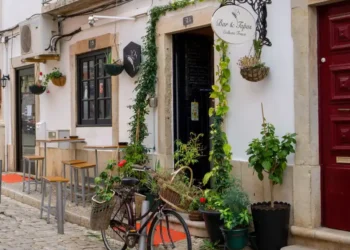The Portuguese love their bread, and broa enjoys a special place in the hearts and stomachs of many.
Broa is a traditional type of bread that holds cultural significance in Portugal, where it has been a staple food for centuries, especially in rural areas.
What’s so special about this bread?
Essentially, the fact that it uses a mix of wheat, corn, and rye flour. Because of that and its taste, texture, versatility, and slightly sweet and tangy flavor, broa is widely enjoyed in Portugal and in Portuguese communities.
Today, broa is seen as a hearty, rustic bread that has an irreplaceable spot in certain occasions and circumstances, having more “character” than regular wheat bread.
Broa not only tastes good, it also looks good. The crust is rustic, similar to sourdough bread, and the inside is firm and dense with few air pockets. Typical of broa are the crackles that form naturally on the crust as it bakes.
Note, in Portugal, you’ll find small cakes, round or oval shaped, that are also called broas. These are sweet like cakes or sweet bread, but dense and heavy. It’s easy to tell the difference: if they’re small, they’re the sweet type of broa.
Where Is Broa Produced?
Historically, this type of bread was more commonly found in North and Central Portugal, where corn and rye were easier to grow than wheat. This also made broa the bread of the poor, so to speak.
Today, it’s still closely associated with those regions, but you can find it virtually everywhere in good supermarkets and bakeries.
Here are the most famous types of broa…
Broa de Loriga Made with white corn flour, salt, and sourdough or baker’s yeast. The shape is round and slightly flat. The interior is dry, porous, and off-white.
Broa de Loriga originates in Loriga, a town in Central Portugal, in the region of Serra da Estrela.
Being deeply rooted in local history, this broa was consumed almost exclusively for more than two centuries, in the context of growing industrial activity.
The bread for home consumption by most families was cooked in community ovens, managed by bakers who organized the entire task of baking the bread.
The breads were identified with “pinches” or holes to know who they belonged to.
Broa de Milho da Beira Alta Made with yellow corn flour, salt, and sourdough or baker’s yeast. It’s traditional from the region of Beira Alta (north-northwest of Central Portugal). This is probably the most common type of broa and the reason why most Portuguese associate this bread with the color yellow.
There are variations on the recipe, but some rye flour is added (from one third
to half of the total amount of flour) to compensate for the lack of gluten from the corn.
Broa de Avintes This bread made in Avintes, a town near Porto, is a dark and dense broa with a flour-covered surface. It’s made with a mix of corn and rye flour and sourdough which is baked for several hours.
The first written reference to it, that we know of, dates back to 1563. Since 1989, Avintes organizes a yearly festival dedicated to its broa.
When Is The Best Time To Eat Broa?
There isn’t a specific circumstance or time of the year for eating broa. However, if you visit any fair or festival that has food stalls, you can expect to find broa.
In most cases you can find it being used in sandwiches (with regional types of cheese and presunto or other cured meats) or as a side for soups and snacks, like flame-grilled chouriço.
If it’s a small event, it’s likely to feature the local type of broa, but if it is a more considerable festival in a city or bigger town, chances are you’ll find different types of broa from different parts of the country.
What’s The Best Way To Enjoy Broa?
When it comes to soup, the quintessential Portuguese pairing is a slice of broa with a bowl of piping hot caldo verde (soup made with a base of potato and onion to which finely shredded Galician cabbage is added, as well as a slice of chouriço. It’s traditional from Minho, in the north of Portugal).
Another common pairing, especially during the summer months, is eating small grilled fish (like sardines) with a slice of broa underneath. The bread soaks up the fat and flavor from the fish.
Other, more sophisticated, uses include cheese and cured meat boards, as well as a dish called bacalhau com broa, where a thick cod loin is covered in crumbled up broa.
Sincerely,
Cátia Lima
Contributor, Europe Uncovered

















